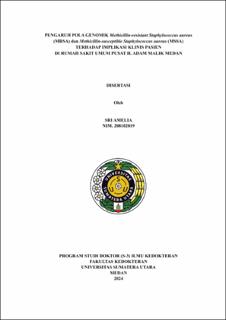| dc.description.abstract | Background: Staphylococcus aureus is a pathogen with significant clinical impact. Its strains
are classified based on their resistance status into Methicillin-resistant Staphylococcus aureus
(MRSA) and Methicillin-susceptible Staphylococcus aureus (MSSA). This study aims to
analyze the genomic patterns of MRSA and MSSA and their implications for clinical outcomes
of patients at H. Adam Malik General Hospital, Medan, with a focus on length of stay, white
blood cell count, and patient mortality.
Methodology: The research was conducted as a prospective cohort observational study,
involving 120 patient samples divided into MRSA isolates (n=60) and MSSA isolates (n=60).
Detection of the resistance gene (mecA) and virulence genes (pvl, nuc, eta, tsst) was performed
using the PCR method, while genomic identification of the protein A-encoding gene was done
using spa-typing sequence analysis.
Results: The study results indicated that MRSA-infected patients had an average age of 51.56
years and a higher mortality rate of 67.6% compared to MSSA-infected patients. All MRSA
isolates contained the mecA gene, while MSSA did not possess this resistance gene. The
characteristics of virulence genes in both S. aureus strains showed a nearly identical pattern,
except for the tsst virulence gene, which was found in only 81.67% of MSSA isolates, indicating
the potential for causing severe disease in both MRSA and MSSA-infected patients (the eta,
pvl, and nuc virulence genes were found in 100% of isolates). Spa-typing analysis identified
several novel spa gene types that had not been previously reported, consisting of t21423 and
t21425 for MRSA isolates and t21449, t21450, and t21456 for MSSA isolates. Six S. aureus
isolates could not be typed for spa gene identification. Clustering using the BURP method
identified 15 clusters with diverse genetic relatedness.
Conclusion: This study concludes that MRSA has a worse clinical impact compared to MSSA.
Additionally, the prevalence of virulence genes found was among the highest compared to other
studies, indicating the need for stricter infection control strategies in hospitals, including
rational antibiotic use and more comprehensive epidemiological surveillance. The use of
methods such as Whole Genome Sequencing (WGS) in the future is expected to provide a
deeper understanding of the genomic patterns of MRSA and MSSA. | en_US |


